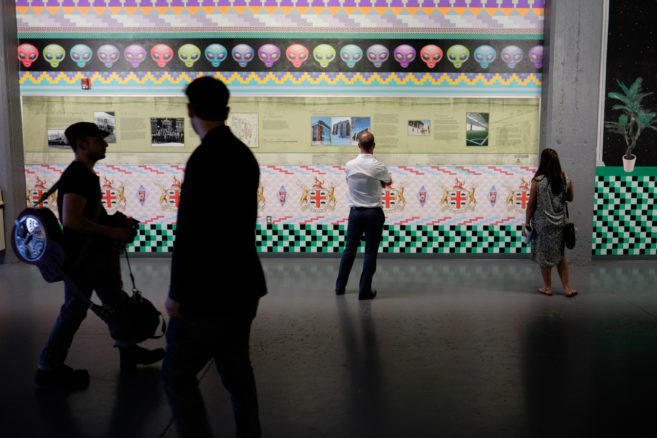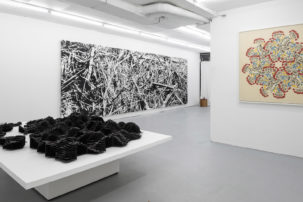On May 21, the day Harold Camping predicted for the end of the world, Atlantic Canadian art enthusiasts gathered in a Cold War–era military bunker. The majority came to the sleepy town of Debert, Nova Scotia, not to escape apocalypse, but to view an exhibition showcasing the work of artists engaging in a playful critique of militarism and exploring the theme of survivalism. A red door, emerging like a rabbit hole from a mound of earth, led patrons through a damp concrete tunnel into a confusing labyrinth of dimly-lit hallways. Visitors trekked into the bowels of the bunker, discovering work by artists Cathy Busby, Barbara Lounder, Robert Zingone, Graeme Patterson, Adriana Kuiper, Daniel Joyce, Ali Nickerson, Cal Lane, Tony Publicover, Brian Penny, Scott Munn, Mitchell Wiebe and Eleanor King.
The bunker was ripe with memories for artists Cathy Busby and Barbara Lounder, who gathered at a barricaded street leading to the bunker in 1984 to protest NATO’s Operation Bold Step. The chosen few hundred people who would live in the bunker in the case of nuclear war filed into the bunker 27 years ago as “a dress rehearsal for World War III,” explained Lounder. By contrast, today the bunker is home to Dataville (a private data-hosting company) and a handful of artists and eccentric characters.
Curator Mitchell Wiebe left bunker visitors to their own devices, as there were no labels or descriptions provided for the artworks. Instead, patrons wandered through long slick hallways divided into numerical zones. In Lounder and Busby’s audio installation, Boldstep Half-Life, the artists’ eerily calm voices bounced unexpectedly off the hallways of Zone 9, the source of the recordings concealed.
As part of the installation, Lounder’s echoey voice sounded, “We are inside this space that is being transformed, not by rhetoric or protest, but by gesture and colour and image and mischief.”
“It’s a fun house! With ghosts, a hidden text and secrets over the secrets,” chimed Busby’s voice. “Mitchell dreams here. It’s a dreaming space, a time outside of daylight.”
Indeed, Wiebe spent months underground painting behind concrete walls 10 inches thick and without natural light as part of an artist residency at the bunker. His large glow-in-the-dark portrait of John Diefenbaker, the prime minister responsible for digging a network of bunkers across the country, hovers like a comical ghost in the black-lit boardroom. Wiebe has engaged in a playful interaction with history here, slipping sporty new details onto historic crests and endowing his older paintings with new layers that can only be viewed under black light.
Relying on found materials, often dating back to the Cold War era, several artists created spontaneous, site-specific installations. Tony Publicover’s installation The Very Last Supper featured a bloody, shot-up banquet of carefully aligned military lunch boxes and empty bullet shells. Valerie Salez’s red-lit installation Waxing Poetic marked the slow passage of time in the bunker as wax dripped from the ceiling onto an antique chair and a hanging bouquet of dried flowers slowly lost its petals.
Artist Graeme Patterson explored the notion of passing the time through repetitive activity. The artist assembled a ping-pong table from found materials in the bunker in what appeared to have once been an office cubicle. Patterson projected a slow-motion video of himself playing ping-pong with a friend on a damp bunker wall, focusing the viewer on the physical dialogue between the two players. Adriana Kuiper’s Underground Leisure provided bunker visitors with a constructive diversion. Built with found wood, the motion of its porch swing activated a car battery, turning a pump that watered plants.
Many exhibitors recontextualized older work in the bunker. Artist Daniel Joyce played on themes of isolation and survivalism, juxtaposing his replication of Winslow Homer’s The Gulf Stream with a copy of Stephen King’s Misery. Robert Zingone’s fibreglass-piping-and-balloon sculptures, which originally served as a critique of the brutalist architecture of the Dalhousie Art Gallery, brought to mind the temporal nature of pop-up structures at expos and fairs. His airy, bulbous sculptures stood in stark contrast to the heaviness and austerity of the space around them, reminding bunker visitors that soon this moment in time would also be buried by new layers of history.

 An installation view of Mitchell Wiebe’s black-lit Diefenbaker portrait at the Dataville Bunker / photo Matthew P. Carswell
An installation view of Mitchell Wiebe’s black-lit Diefenbaker portrait at the Dataville Bunker / photo Matthew P. Carswell






